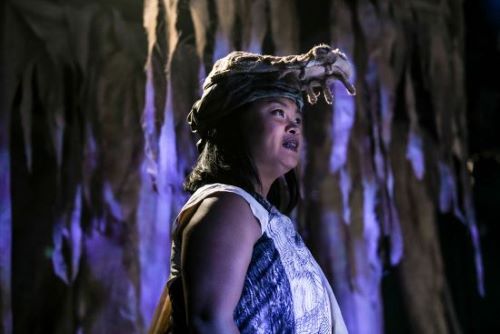
A history-based piece that is relevant and topical in today’s world.
Cahoots Theatre and b.current performing arts presents Hilot Means Healer – a unique take on a historical moment that resonates today.
I should preface this review by stating I became acutely ill just before the show started, so I was in considerable physical discomfort throughout. I regret that I was less present for this show and I feel like I may have missed some things. I apologize in advance if that leads me to misrepresent this show in some way.
Hilot Means Healer takes place in the countryside outside Manila during World War II. The events of the play occur during The Battle of Manila and in the context of Japan’s occupation of The Philippines.
Manang Flor (played by Carolyn Fe), a Babaylan mangihilot (healer) lives outside of Manila with a young woman named Alma (Belinda Corpuz). At the start of the show, Manang Flor discovers a young man named Alfredo (Aldin Bundoc) hiding in her garden. She initially takes him in to treat his gunshot wound but Alfredo ultimately stays for longer than anyone intended.
Despite my own limitations, I quite enjoyed this show. I feel like it is a well produced piece, and it served as a major learning opportunity for me. I came into this show highly uninformed about The Battle of Manila, Babaylan people, and the Japanese occupation of the Philippines, and left with a profound curiousity to read more.
While at first blush this seems like a period piece, this play is quite relevant to our current climate crisis and worldwide treatment of Indigenous peoples.
Woven throughout the script (by Jo Simalaya Alcampo) is the importance of the Babaylans’ relationship to the land, and the importance of recognizing its agency. One line that stands out to me is, “how can you claim land?”. The way the Babaylan characters relate to the land can be said about many Indigenous people around the world, emphasizing the importance of being in relationship to the land in a manner that honours its limited resources (themselves being sacred and possessing agency).
This show felt uniquely immersive thanks to Jung-Hye Kim’s design (set, costume, and props), Jareth’s Li’s lighting design, and MaryCarl Guiao’s music composition and live performance using traditional Filipino instruments. Kim’s depiction of the balete tree should be especially commended and Guiao’s inventive composition made me feel transported.
Hilot Means Healer features a cohesive cast under the direction of Jasmine Chen. It felt like such a treat to see the characters’ relationships develop throughout the play, especially the one between Ligaya (Karen Ancheta) and Manang Flor.
At the start of a few scenes I was confused about the setting, and this only became clear by the dialogue later in each scene. It’s a small critique to an otherwise well directed piece, but I still felt a little lost at times.
Seeing this play prompted me to think about other shows I’ve seen that were inspired by historical moments. I realize the ones that resonate the most make me think about parallels to current events. I would certainly count Hilot Means Healer among them; thinking about Indigenous land and water protectors makes this piece very topical.
Between the script, music, design, and performance (not even mentioning the lessons learned along the way), this show is well worth attending.
Details
- Hilot Means Healer is playing until October 27, 2019 at The Theatre Centre BMO Incubator (1115 Queen Street West)
- Shows run Tuesday to Saturday at 7:30pm and Sundays at 2pm
- Audio-Described Performances: Friday, October 18 at 7:30pm and Friday, October 25 at 7:30pm
- Relaxed performances: Sunday, October 13th at 2pm and Sunday, October 20 at 2pm
- Ticket prices are $20 for students, seniors, and arts workers. Regular adult tickets are $25.
- Tickets are available online, by phone at 416-538-0988, or in person at the box office
Photo of Karen Ancheta by Dahlia Katz
